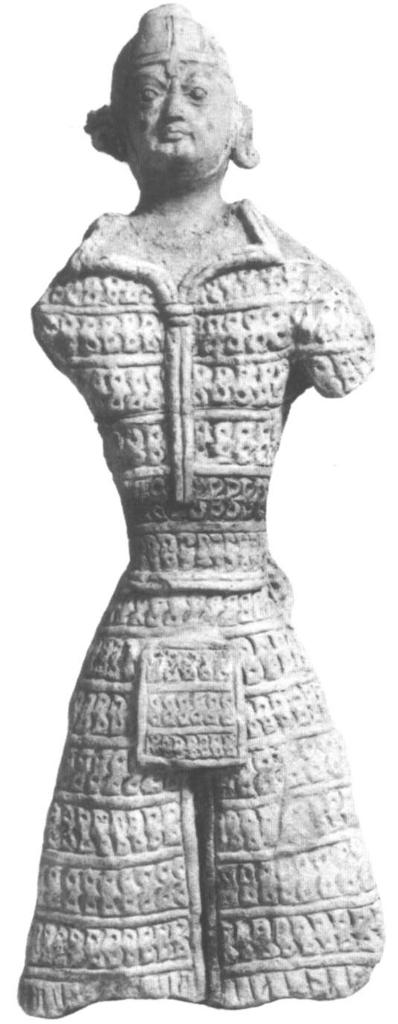Tamara Talbot Rice
ANCIENT ARTS OF
CENTRAL ASIA
Statuette of a Warrior from Sorçuk

Curator's comments and a larger image of a Statuette of a Warrior from Sorçuk

Illustration 171, p184 in Tamara Talbot Rice, Ancient Arts of Central Asia, 1965
171 Carved stucco statuette of a warrior wearing armour almost identical to that worn by the knights in Sodgdian and Choresmian paintings.
This comes from the Mingoi caves near Sorçuk, and although dating from the eighth to tenth century, it retains many points that link it to more westerly art of a far earlier date
Referenced on pp. 173-4, vol. 1, The military technology of classical Islam by D Nicolle
The spread of lamellar armour from Central Asia across the Muslim world is altogether easier to chart. Its terminology is generally less contentious and the illustrated material is simpler to interpret. As discussed earlier: such a form of defence may have originated in the ancient Middle East but by the immediate pre-Islamic centuries lamellar armours of iron or a mixture of iron and bronze were far more characteristic of Central Asia and eastern Iran than the Fertile Crescent35 (Figs. 61, 67, 82, 428, 435, 437, 440, 443, 451, 453, 454, 455, 462, 463, 464, 471, 472, 474, 478, 480 and 481). There is, however, some evidence to suggest that they were known in 7th century Arabia, although they are likely to have been rare.36 Indeed, lamellar would seem to have been highly prized and expensive even in those Transoxanian regions where it was not common, and remained so well into the Muslim era.37
The increased importance of lamellar in eastern Islam and in the partially subdued Christian regions of the Caucasus is clearly documented as is its spread westward into Muslim Anatolia towards the end of the period under review39 (Figs. 220B, 306, 309, 316, 348, 410, 442, 444, 447, 638, 641 and 642C). References could be multiplied ten- or twenty-fold if one included all those concerning armours known to be of lamellar, such as the jawshan and kamarband, rather than simply those that described lamellar, its appearance, construction or fastenings.
35. Robinson, Oriental-Armour p. 130; Laufer, op. cit., pp. 208 and 214; W. Hauser, "The Persian Expedition, 1933-1934," Bulletin of the Metropolitan Museum of Art XXIX (1934), p. 8.
36. Schwarzlose op. cit., pp. 327 and 346.
37. Narshakhī, op. cit., p. 46; al Ṭabarī: op. cit., vol. II, pp. 256 and 1889.
38. Firdawsī, op. cit., pp. 270, 273, 427, 688 and 953; Anon., The Book of Dede Korkut, p. 166; Rust'haveli, op. cit., verse 220.
Referenced on p.15, The Armies of Islam 7th-11th Centuries by David Nicolle & Angus McBride
The large lamellar cuirasses of Turkestan figure in much Central Asian art. This style of armour had a profound influence on Islamic fashions. This 9th century stucco figure from eastern Turkestan has a splinted spangenheim with a short nasal, and a long cuirass probably of leather lamellar. The shield on the left is associated with this figure. (British Museum)